A Favorite Paris Park – and the Project to Save It


Major works are afoot at one of Paris’s best-loved parks. A €6m restoration is planned for the 150-year-old Parc des Buttes-Chaumont in the 19th arrondissement, a green lung in one of the most densely-populated areas of the city. When it is completed the park will have undergone the biggest renovation in its history.
The name Chaumont translates as “Bald Hill” because the mineral composition of the subsoil meant that vegetation never grew. It was always a desolate spot: right back in the 13th century it was known as Montfaucon and the site of Paris’s gibbet. In those days hanged people were left to rot in the open air. After the French Revolution it became a refuse tip, then a site for butchering horse carcasses, and finally a place to dump sewage. All in all a thoroughly pleasant welcome to France’s capital!

Parc des Buttes-Chaumont by Traktorminze/ Wikipedia
In the 19th century, this northeastern corner of Paris was honeycombed with gypsum quarries (hence plaster of Paris). By the 1860s, the quarries were exhausted and the area a polluted and abandoned wasteland. Enter Emperor Napoleon III who was a great fan of English parks, having lived in London while in exile. He instructed his director of public works (who went by the unwieldy name of Jean-Charles Adolphe Alphand) to design a new park on the quarry site in the informal, landscaped English style. Alphand had already designed the Bois de Boulogne and Bois de Vincennes and he brought the same faux-rural aesthetic to this project.
The result was one of Paris’s most beautiful green spaces, a million miles away from France’s traditional geometric formality seen in gardens such as the Tuileries or Luxembourg. Alphand took full advantage of the waste heaps to sculpt undulating grassy slopes. A large lake was created in the middle, fed by a mini waterfall and stream tinkling over stones so that you can (almost) imagine you’re in the countryside. Then Alphand let his imagination run riot. He built a high cascade and grotto, stalactites, and a winding path climbing up to the Greek Temple de la Sybille on its manmade island and its wonderful “belvedère,” or view, across northern Paris.
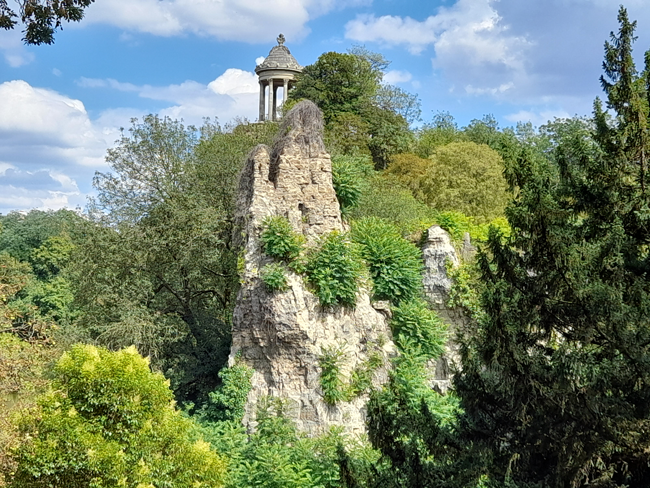
The unstable Temple de la Sybille © Pat Hallam
The park was a marvel of modern engineering, labor and ingenuity. Explosives sculpted the picturesque cliffs and grotto. A hydraulic system brought water from the Canal de l’Ourcq to feed the waterfalls. A thousand laborers dug the lake, shaped the slopes and planted thousands of flowers and trees in 200,000 cubic meters of imported topsoil. When the park opened in 1867 (to coincide with the Exposition Universelle), it quickly became a great attraction for the thousands of working-class Parisians trapped in cramped, insanitary apartments in Belleville and Ménilmontant.
Today you can still stroll round the lake and explore the paths on several levels that wind around thickly wooded copses. In keeping with Mayor Anne Hidalgo’s drive for biodiversity in the city, some slopes have been left to self-seed as wildflower meadows, thus attracting insects and other invertebrates. Those that are still mown are perennially popular with Parisians for picnicking and sunbathing. The disused railway the Petite Ceinture runs through the middle of the park while two footbridges link upper paths with the Île du Belvedère. Children have plenty to amuse them in the shape of playgrounds, swings, pony rides, and Le Guignol theater which still presents marionette shows.
There are three café-restaurants to refresh visitors. Rosa Bonheur is housed in an original brick-and-wood pavilion and carries on the tradition of the guinguette: in the evenings, tables are pushed back and the floor given over to dancing. Thursdays are electro nights, particularly attracting a gay-friendly audience. The café aims to bring the flavors of the South to Paris with its tapas menu of Serrano ham, goat’s cheese from the Cévennes, fig tapenade and wines from the Camargue and the Var in Provence.
In contrast, Le Pavillon Puebla plays up its bucolic setting with two terraces set among chestnut trees as well as a swing and Moroccan chairs. Informality is the order of the day here as well, with dips, pizzas and planches of cheeses and charcuterie to eat. Since it is owned by the same group that manages the various Perchoir rooftop bars around Paris, cocktails feature heavily at La Puebla. This winter it intends to go alpine with a chairlift to the park slopes, and raclette on the menu!
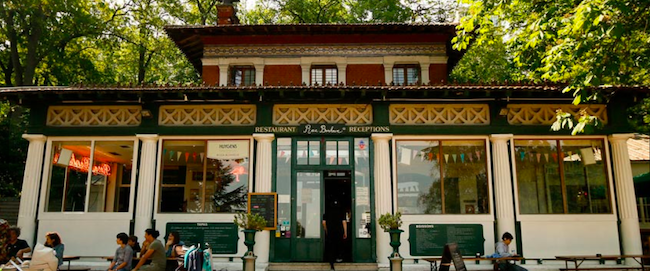
Rosa Bonheur des Buttes Chaumont. Photo credit © Rosabonheur.com
The third cafe, Le Pavillon du Lac, is situated on one of the upper paths and overlooks the lake. While both Rosa Bonheur and La Puebla are evening spots, Le Pavillon du Lac is open during the daytime and is a more traditional cafe-restaurant with a weekday lunch formule and brunch on the weekend.
But major works are urgently needed because of problems with the park’s foundations – literally. The inherent instability of building a park on tunnels of plaster means that, 150 years later, time is catching up. Parts of the park are in danger of falling down. To address these concerns, in 2021 the Ville de Paris called in the National Inspectorate of Quarries and the Research Office for Geology and Mines to undertake the most in-depth assessment of the park since its construction. Drawing on the city’s extensive archives plus their own observations onsite, they have so far drawn up an initial picture of the state of the park. As well as various areas at risk of collapse, this has identified fissures in the lake and the small waterfall, and subsidence. This preliminary study will be followed by a thorough section-by-section analysis of the park using state-of-the-art mapping techniques. This will create a detailed study above and below ground.
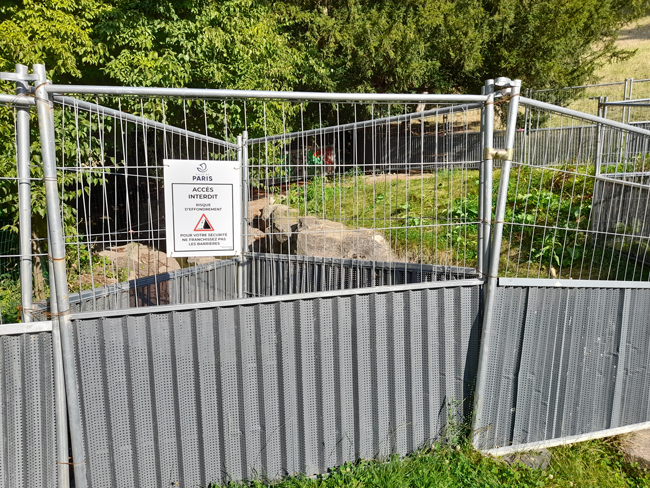
Some areas are already cordoned off to the public in the Parc des Buttes-Chaumont. © Pat Hallam
Renovating the park will be a long process. The geological studies alone are expected to take another two years to complete. Running concurrently, from 2023, construction companies will be invited to tender for the contract to undertake the necessary repairs and stabilization works. In 2024 an exhibition will trace the history of the park, followed by cleaning out the lake. Then, the works will finally begin, which themselves will take another two and a half years to complete. The final completion date is not scheduled until 2026.
Happily for visitors, the park will remain open throughout. The Ville de Paris has reassured us that only 5% of the park will be closed, leaving 95% accessible. However, barriers have already been erected in some areas for safety reasons, preventing access to the grotto, the large cascade, and where the stream flows into the lake. The Temple de la Sibylle is at particular risk and has been closed to the public for several months.
The intention is that the park will be stabilized for the long term. If we could travel forwards in time another 150 years, to 2172, perhaps we would see the Parc des Buttes-Chaumont still perched above Paris, still providing an airy escape for Parisians.

© Jean-Louis Vandevivère at Creative Commons
Lead photo credit : Parc des Buttes Chaumont © Jean-Louis Vandevivère at Creative Commons
More in Bald Hill, Parc des Buttes Chaumont, sustainability, Temple de la Sybille

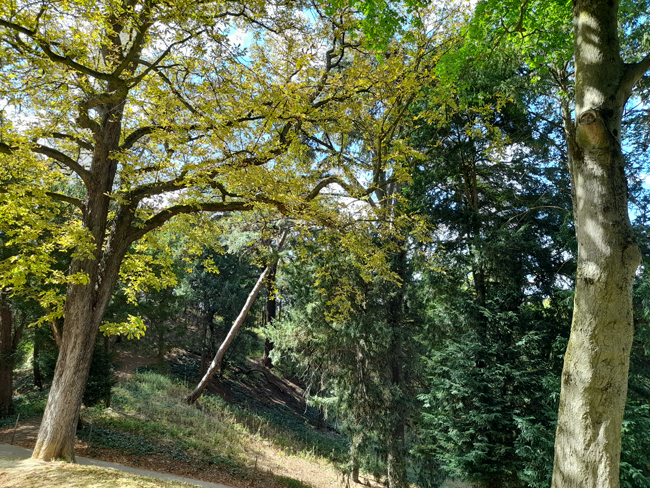
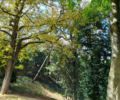
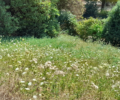
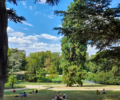



REPLY
REPLY